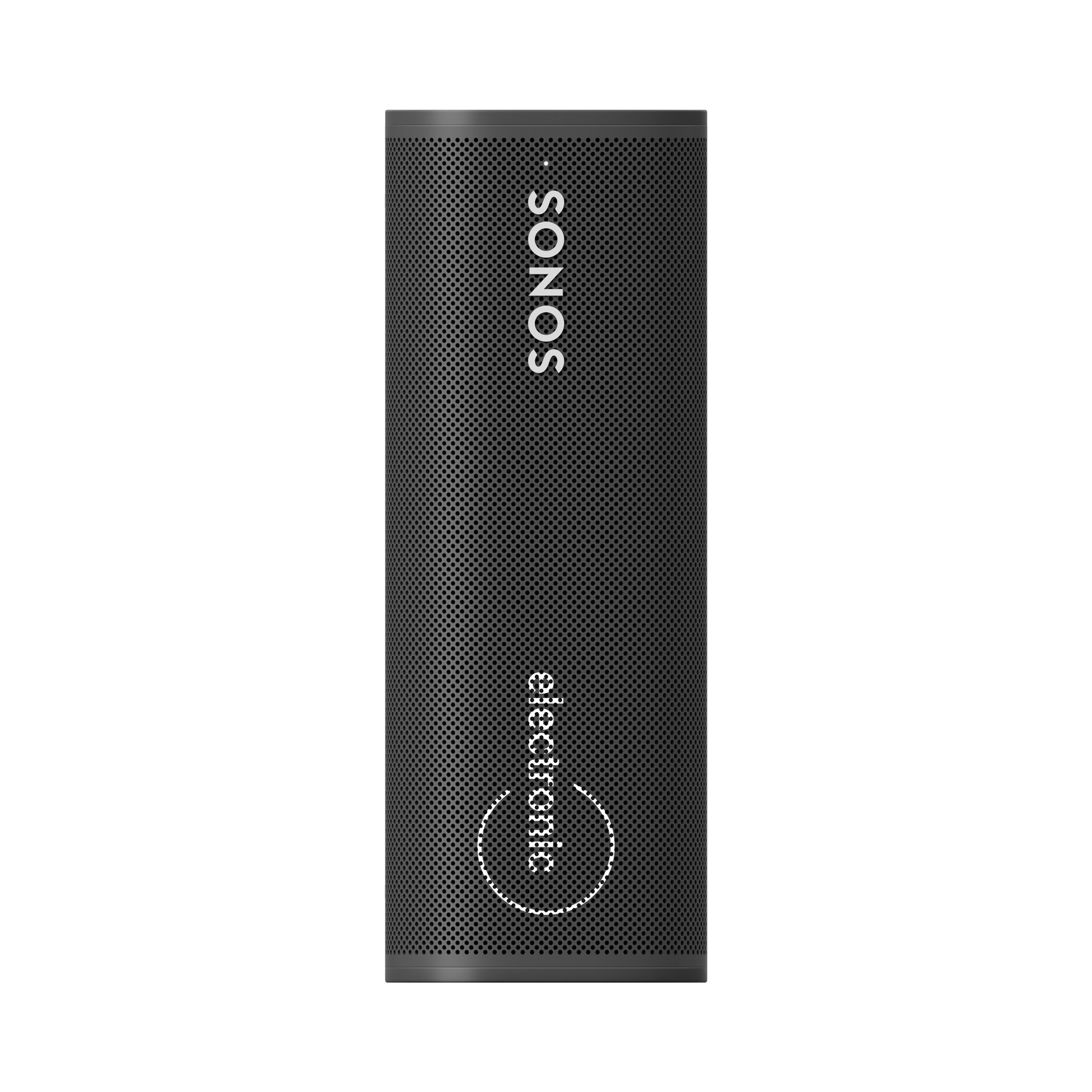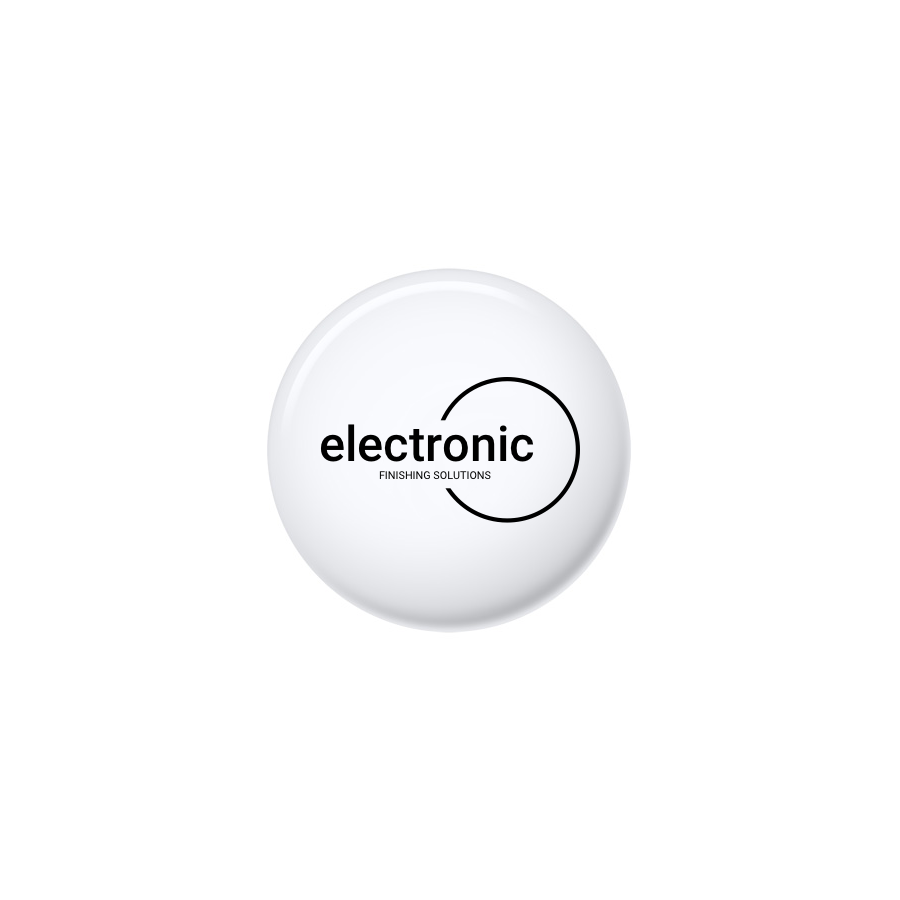Planning a marketing event can feel like juggling a dozen tasks at once, each one critical to success. Whether you're launching a new product, generating leads at a trade show, or fostering client relationships, the difference between a memorable success and a costly failure lies in the details. A scattered approach leads to missed deadlines, budget overruns, and a stressful experience for everyone involved. That's why a comprehensive marketing event checklist template isn't just a helpful tool; it's the strategic foundation for every successful outcome.
This guide breaks down the entire process into eight manageable, actionable stages. We’ll provide a repeatable framework to ensure every marketing event you plan is a resounding success, transforming the process from a source of chaos into a streamlined, strategic advantage. For a practical tool to manage your event preparations, consider utilizing a comprehensive corporate event planning checklist to complement this strategic overview. We'll cover everything from setting clear, data-driven goals to analyzing post-event ROI. Let’s dive into the blueprint for flawless execution.
1. Define Event Goals and Objectives
Before a single dollar is spent or a venue is booked, the most critical step in your marketing event checklist template is defining what success looks like. Establishing clear, measurable goals and objectives is the foundation upon which every subsequent decision rests. Without this clarity, your event risks becoming a collection of activities with no discernible impact on your business. This initial phase involves a deep dive into what you aim to achieve, transforming abstract ambitions into concrete, actionable targets.
The Power of SMART Goals
The SMART framework, popularized by George T. Doran, is an indispensable tool for this process. It ensures your objectives are not just vague aspirations but are Specific, Measurable, Achievable, Relevant, and Time-bound. This structure provides a clear roadmap and holds your team accountable for the outcomes.
- Specific: Instead of "increase brand awareness," aim for "secure 25 media mentions in top-tier industry publications."
- Measurable: Define Key Performance Indicators (KPIs) like lead generation, conversion rates, or social media engagement metrics.
- Achievable: Set ambitious but realistic targets based on your budget, resources, and historical data.
- Relevant: Ensure your event goals align directly with broader company objectives, such as entering a new market or supporting a major product launch.
- Time-bound: Assign clear deadlines for achieving these goals, such as "generate 500 qualified leads by the end of the two-day conference."
From Theory to Practice
Major industry events exemplify goal-driven execution. Salesforce's Dreamforce, for instance, sets massive goals for attendee numbers and pipeline generation, influencing every aspect of its planning. Similarly, Apple's product launches are meticulously engineered to dominate global media cycles and trigger immediate sales, demonstrating an intense focus on specific, measurable outcomes. Involving key stakeholders from sales, marketing, and product teams during this goal-setting phase ensures company-wide alignment and a more holistic view of what success entails.
To help you visualize how to structure your event's core metrics, this summary box breaks down the essentials of goal setting, KPI tracking, and ROI measurement.
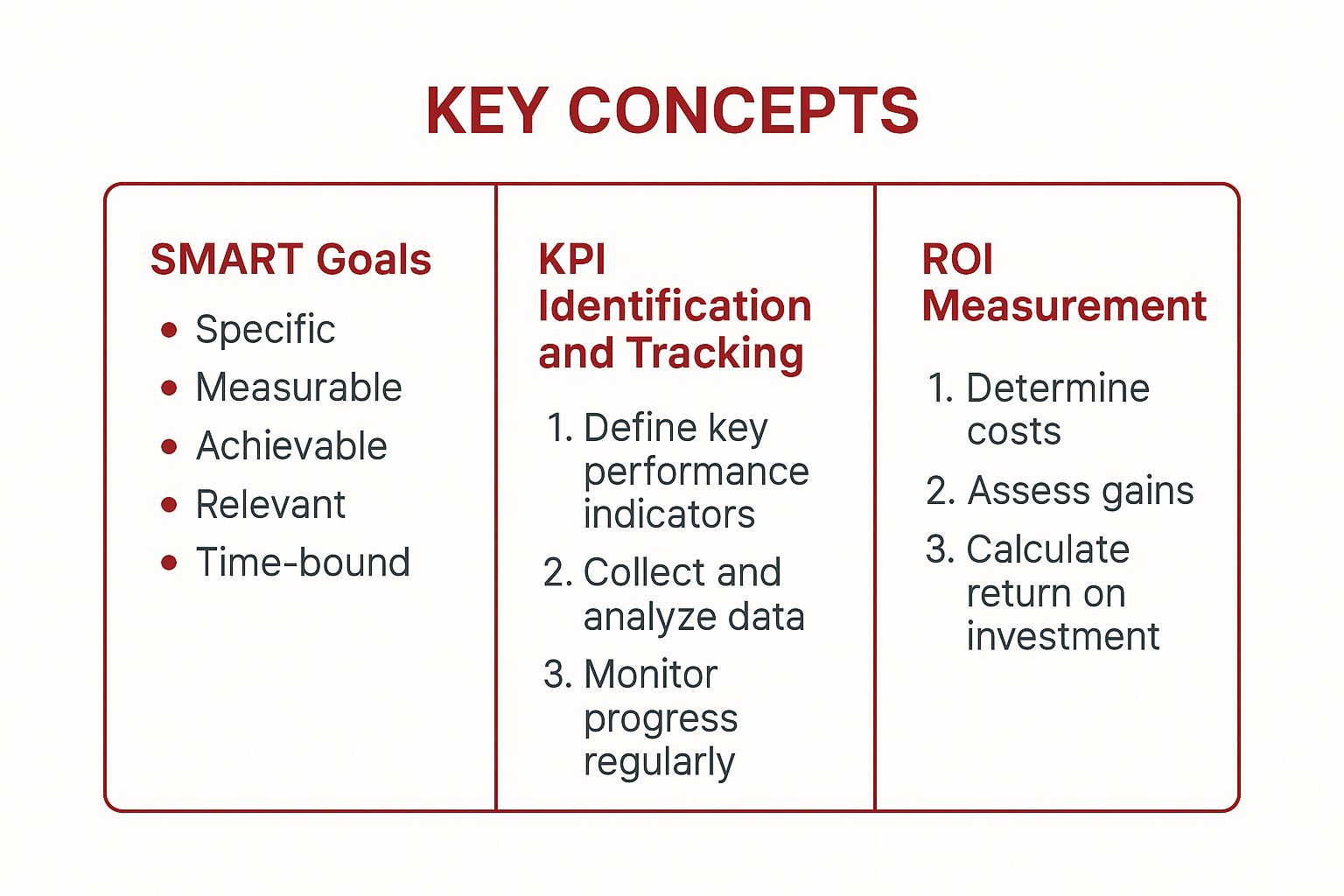
This framework provides a clear, structured approach to ensure your objectives are robust and your success can be definitively measured against your initial investment. By documenting these goals and sharing them across all teams involved, you create a unified vision that guides the entire event lifecycle.
2. Budget Planning and Resource Allocation
With clear goals established, the next crucial component of your marketing event checklist template is creating a comprehensive budget. Meticulous budget planning and resource allocation are the financial bedrock of your event, transforming your objectives into a tangible reality. This process involves a detailed breakdown of all potential expenses, from high-cost items like venue rental and technology to smaller details like marketing materials and post-event follow-up.
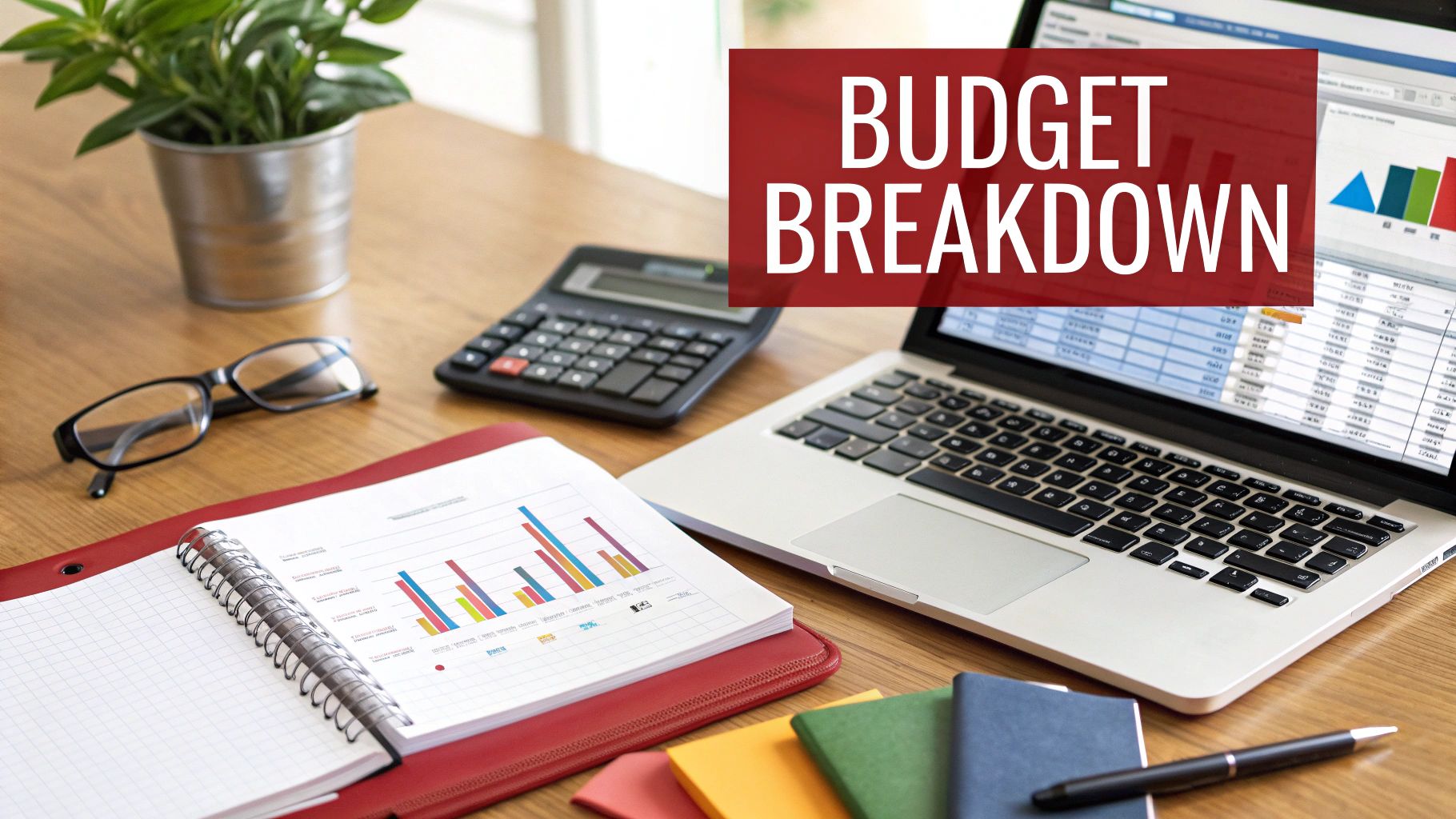
This financial roadmap ensures every dollar is strategically assigned to maximize return on investment (ROI). It also necessitates building in a contingency fund, typically 10-15% of the total budget, to cover unforeseen costs and prevent last-minute financial crises.
The Art of Financial Scoping
Effective budgeting is a practice honed by professional event planning associations like MPI and PCMA, and it scales to any event size. From a multi-million dollar affair like Google I/O, which allocates its massive budget across venue, technology, and global marketing, to a small business spending $5,000 on a trade show booth, the principles remain the same. The key is to break down costs into fixed (e.g., venue hire) and variable (e.g., per-person catering) categories to accurately forecast expenses.
- Venue & Logistics: Includes rental fees, insurance, security, and permits.
- Technology: Covers AV equipment, Wi-Fi, registration software, and live-streaming platforms.
- Marketing & Promotion: Encompasses digital ads, content creation, PR, and promotional materials.
- Speakers & Talent: Fees, travel, and accommodation for guest speakers or entertainers.
- Food & Beverage: Catering costs, which often represent a significant portion of the budget.
- Staffing: Includes event staff, volunteers, and potentially your team's time.
From Theory to Practice
Strategic resource allocation requires more than just listing expenses; it involves making smart trade-offs. For example, a non-profit gala might prioritize an impressive venue to attract high-value donors, while a tech startup might invest more heavily in a seamless event app and lead capture technology. The goal is to align spending directly with your primary event objectives. This means getting multiple quotes from vendors, negotiating payment terms to manage cash flow, and tracking actual spending against your projections on a weekly basis. For a deeper dive into structuring your finances, you can explore this event budget planning template. By using budgeting software and maintaining rigorous documentation, you ensure financial accountability and create a clear path to profitability.
3. Target Audience Identification and Persona Development
Once your event goals are defined, the next critical task in your marketing event checklist template is to pinpoint exactly who you need in the room to achieve those goals. Identifying your target audience and developing detailed attendee personas ensures that every element of your event, from content to catering, is tailored to attract and engage the right people. This process moves beyond basic demographics to understand the motivations, challenges, and expectations of your ideal attendee, creating a foundation for a truly resonant experience.
The Power of Detailed Personas
Creating detailed buyer personas, a practice championed by marketing experts like Seth Godin, transforms abstract audience segments into relatable human profiles. These personas are fictional, research-based representations of your ideal attendees. They provide a clear and empathetic framework for your team to use when making decisions about programming, messaging, and overall event design, ensuring every choice is audience-centric.
- Demographics & Psychographics: Go beyond job titles and company size. What are their career aspirations, daily frustrations, and professional interests?
- Motivations & Pain Points: What problems are they trying to solve? What knowledge or connections are they seeking that would make attending your event a must?
- Behavioral Patterns: How do they consume information? Are they active on LinkedIn, prefer email newsletters, or follow specific industry influencers?
- Event Expectations: What kind of event experience do they value? Are they looking for high-level networking, hands-on workshops, or inspirational keynotes?
From Theory to Practice
Major industry events demonstrate the power of precise audience targeting. Adobe Summit, for example, meticulously crafts its agenda for specific marketing roles like creative directors, data analysts, and CMOs, ensuring relevant tracks for each persona. Similarly, medical conferences are hyper-focused, targeting physicians based on their specific specialty and career stage to guarantee maximum relevance and value. By creating 3-5 distinct personas, you can avoid generic planning and instead design an event that speaks directly to the needs of your most valuable potential attendees.
To help you build these profiles, focus on actionable research methods.
This structured approach ensures your marketing efforts are laser-focused, attracting individuals who are most likely to convert into leads, customers, or brand advocates. Documenting these personas and sharing them with your entire event team and key stakeholders creates a shared understanding of who you are serving and why it matters.
4. Venue Selection and Logistics Coordination
The physical environment of your event is a powerful extension of your brand and a critical factor in attendee experience. Choosing the right venue goes beyond just securing a space with enough capacity; it's about finding a location that aligns with your event’s goals, enhances your messaging, and facilitates seamless execution. This step in your marketing event checklist template involves a detailed evaluation of potential sites and the meticulous coordination of all logistical elements, from parking and accessibility to technical infrastructure and emergency preparedness.
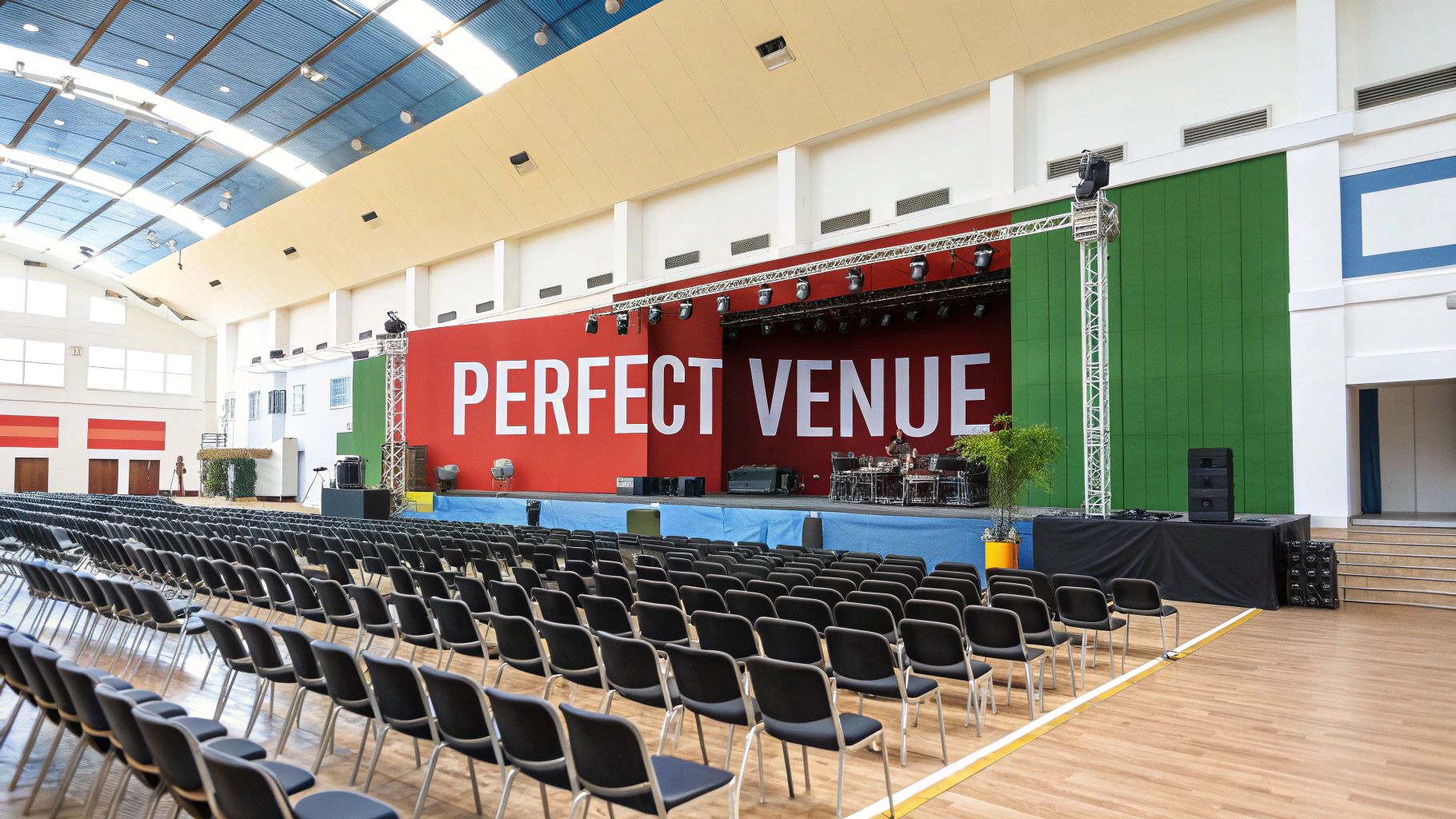
Beyond the Four Walls
A venue should be more than a container; it should be a strategic asset. The selection process requires a holistic approach that considers atmosphere, accessibility, and technical capabilities in equal measure. A perfect venue enhances the attendee journey from the moment they arrive, creating an immersive experience that supports your core objectives.
- Atmosphere and Brand Alignment: The venue's ambiance should reflect your brand’s personality. A luxury brand might choose a high-end hotel, while a tech startup might opt for a modern, industrial loft.
- Accessibility and Convenience: Consider how easily attendees can reach the venue via public transport or car. Ample parking, clear signage, and accessibility compliance (e.g., ramps, elevators) are non-negotiable.
- Technical Infrastructure: Confirm the venue's Wi-Fi capacity, A/V equipment quality, and power supply. Can it support your presentations, live streams, and interactive elements without a hitch?
- Contingency Planning: What is the backup plan for bad weather for an outdoor event? Does the venue have protocols for medical emergencies or power outages?
From Theory to Practice
Iconic events demonstrate how venue selection amplifies impact. TED Talks are often held in architecturally significant spaces like the Vancouver Convention Centre, whose modern design and waterfront views contribute to a forward-thinking, inspiring atmosphere. New York Fashion Week frequently utilizes unconventional venues, from historic warehouses to art galleries, to create a unique and memorable backdrop for designers' collections. By carefully matching the location to the event's purpose, these organizations turn a physical space into a core part of the narrative.
Thorough site visits are essential. Walk through the space imagining the flow of your event, test the technical equipment, and meet the on-site staff. Negotiating contract terms, including cancellation policies and included services, is equally important to protect your investment and ensure a smooth partnership. By diligently managing these details, you create a stable foundation for a successful and memorable marketing event.
5. Marketing and Promotion Strategy
Once your goals are set and your budget is approved, the next critical task in your marketing event checklist template is crafting a comprehensive promotion strategy. This isn't just about sending a few emails; it's about building a multi-channel campaign that generates buzz, drives registrations, and ensures your target audience shows up. A well-executed marketing plan creates momentum, builds a community around your event before it even starts, and maximizes attendance.
A Multi-Channel Promotional Mix
An effective promotion strategy leverages a diverse mix of channels, each reinforcing the others to create a powerful, unified message. Relying on a single channel is risky; a holistic approach ensures you reach your audience wherever they are. Crafting compelling messages for your event website, registration pages, and promotional materials is key; review these website copywriting tips to boost conversions and maximize attendee sign-ups.
- Email Marketing: Nurture leads with a segmented email sequence that includes announcements, speaker highlights, early-bird offers, and last-chance reminders.
- Social Media: Use a consistent event hashtag, create shareable visual content, and run targeted ad campaigns on platforms like LinkedIn, X (formerly Twitter), and Instagram.
- Content Marketing: Publish blog posts, case studies, or whitepapers related to your event's theme to attract an organic audience and position your brand as a thought leader.
- Partnerships: Leverage the networks of your speakers, sponsors, and media partners to amplify your reach far beyond your own audience.
From Theory to Practice
Major events are masters of promotional execution. SXSW builds year-round engagement through continuous content and social media interaction, making its event a cultural touchstone. Likewise, CES utilizes strategic media previews and influencer partnerships to generate massive pre-event hype, guaranteeing global coverage. On a smaller scale, local business events often find success by partnering with community organizations and leveraging local media to drive attendance from a geographically targeted audience.
To help you build a robust promotional calendar, this summary box breaks down the key phases and tactics for a successful event marketing campaign.
| Phase | Timeline | Key Channels & Tactics |
|---|---|---|
| Pre-Launch | 12+ Weeks Out | Finalize branding & messaging. Secure initial partners & speakers. Prepare core assets. |
| Launch & Awareness | 8-12 Weeks Out | Announce event & open registration. Launch email & social media campaigns. Begin content marketing. |
| Momentum Building | 4-8 Weeks Out | Share speaker spotlights. Promote early-bird deadlines. Activate sponsor & partner promotions. |
| Final Push | 1-4 Weeks Out | "Last chance" messaging. Highlight key sessions & networking opportunities. Finalize attendee comms. |
This structured timeline ensures your promotional efforts are consistent and build upon each other for maximum impact. A well-defined promotional strategy not only fills seats but also establishes the value and excitement of your event long before the doors open. Learn more about how to build an effective event marketing strategy template to boost your event's success.
6. Registration and Attendee Management System
A seamless attendee experience begins long before the event doors open, starting with the very first interaction: registration. Implementing a robust registration and attendee management system is a non-negotiable part of any modern marketing event checklist template. This technology is the central nervous system for your event, handling everything from ticket sales and data collection to automated communications and onsite check-in, ensuring a smooth, professional journey for every participant.

The Power of Integrated Systems
An effective registration platform goes far beyond a simple payment form. The best systems integrate directly with your CRM, automatically populating attendee data for post-event follow-up. This creates a powerful, unified view of your audience, transforming registration from a logistical task into a strategic data-gathering opportunity. This approach, championed by event tech giants, ensures that every piece of information collected serves a purpose in your wider marketing and sales funnels.
- Specific: Instead of just collecting names and emails, capture job titles, company sizes, and specific interests to personalize the event experience and segment your audience.
- Measurable: Track real-time registration numbers against capacity, monitor revenue from different ticket tiers, and analyze open rates for automated confirmation and reminder emails.
- Achievable: Select a platform that matches your event's scale. A simple tool might suffice for a small workshop, while a large conference needs a comprehensive solution.
- Relevant: Ensure the data you collect aligns with your event goals. If lead generation is key, your registration form must capture lead-qualifying information.
- Time-bound: Implement early-bird pricing with clear deadlines to incentivize prompt registration and help forecast attendance numbers accurately.
From Theory to Practice
Platforms like Cvent and Eventbrite have become industry standards by providing scalable solutions for events of all sizes. Cvent is renowned for managing complex corporate conferences and trade shows, offering deep integration and analytics. For more unique, community-driven events, custom-built systems like the one used for Burning Man demonstrate how a tailored registration process can manage immense demand and reinforce an event's exclusive culture. These examples highlight how the right system not only simplifies logistics but also enhances the brand and attendee perception from the outset.
To help you visualize the key components of a successful registration setup, this summary box breaks down the essentials of system selection, data management, and the attendee journey.
This framework provides a clear, structured approach to ensure your registration process is efficient, user-friendly, and strategically aligned with your event objectives. By prioritizing a powerful and reliable system, you lay the groundwork for a flawless attendee experience and gather invaluable data to prove your event's ROI.
7. Content and Speaker Coordination
The substance of your event, the very reason attendees invest their time and money, is its content. Curating high-quality content and securing engaging speakers who align with your event goals is a cornerstone of your marketing event checklist template. This step transforms your event from a simple gathering into a must-attend experience, delivering tangible value that resonates long after the closing remarks. It involves diligent speaker research, outreach, contract negotiation, and content development support to ensure a seamless and impactful program.
Building a World-Class Agenda
Your content and speakers are the primary drivers of registrations and audience satisfaction. The key is to source individuals who are not only experts in their field but are also captivating presenters. This requires a strategic approach that goes beyond simply filling speaking slots; it’s about crafting a cohesive narrative for your event.
- Speaker Research: Identify industry thought leaders, C-level executives, and dynamic workshop facilitators. Look for individuals with a strong following who can help promote the event.
- Clear Guidelines: Provide speakers with a comprehensive brief detailing your audience demographics, event theme, key takeaways you want them to deliver, and presentation format requirements.
- Rehearsal and Tech Checks: Never leave presentations to chance. Schedule mandatory technical rehearsals with each speaker to test their equipment, internet connection (for virtual events), and presentation flow.
- Contingency Planning: What happens if a speaker cancels at the last minute or faces a technical meltdown? Have a backup plan ready, whether it’s a pre-recorded session, a standby speaker, or a panel discussion you can deploy instantly.
From Theory to Practice
Legendary events are built on the back of exceptional content. TED conferences are the gold standard, meticulously curating world-class speakers to deliver powerful, thought-provoking "ideas worth spreading." Similarly, major industry conferences feature top executives and experts whose presence alone can drive ticket sales. For smaller events like educational seminars, securing a hands-on facilitator who can provide practical, actionable training is equally critical. To further enhance the speaker experience and show appreciation, consider offering premium gifts. You can find more inspiration with these 10 event giveaway ideas to wow your audience.
To help you organize this critical process, this summary box outlines the key stages of speaker and content management.
This structured approach ensures your content is not only high-quality but also professionally delivered. By coordinating closely with your speakers and supporting them throughout the process, you guarantee a polished, engaging program that meets audience expectations and reinforces your event's value proposition.
8. Post-Event Follow-up and ROI Analysis
The work isn't over when the last attendee leaves. In fact, one of the most crucial phases of your marketing event checklist template begins right after the event concludes. A systematic post-event follow-up and Return on Investment (ROI) analysis are what separates a memorable occasion from a measurable business success. This process transforms event engagement into tangible outcomes, ensuring that the momentum generated translates into leads, sales, and valuable insights for the future.
The Power of Post-Event Nurturing
Effective follow-up is a strategic, multi-faceted effort that keeps the conversation going and guides attendees down the sales funnel. It's about delivering continued value and demonstrating that you were listening. This is where you capitalize on the connections made and reinforce your brand message, turning warm leads into loyal customers.
- Timely Communication: Send initial follow-up communications, like a thank-you email with a survey link, within 24 to 48 hours while the event is still fresh in attendees' minds.
- Segmentation: Don't send a generic blast to everyone. Segment your audience based on their engagement level, session attendance, or interactions with your sales team for highly personalized nurturing campaigns.
- Content Sharing: Distribute valuable content like session recordings, presentation slides, and key takeaways to reinforce the value provided and extend the life of the event.
- Long-Term Tracking: Your analysis should go beyond immediate metrics. Track long-term conversion rates and the customer lifetime value (CLV) of event-generated leads to understand the full impact.
- Document Lessons Learned: Conduct a thorough debrief with your team to capture what worked, what didn’t, and how to improve future events.
From Theory to Practice
This strategic follow-up is exemplified by major industry players. Salesforce, for example, is renowned for its post-Dreamforce follow-up, where attendees receive personalized outreach from sales teams based on the sessions they attended and the solutions they explored. Similarly, trade show exhibitors who meticulously categorize leads and enter them into automated email nurturing campaigns see significantly higher conversion rates than those who let leads go cold. This structured approach is essential for demonstrating value and justifying event expenditure.
To help you systematically evaluate your event’s performance, you need a solid framework for data analysis. Understanding how to measure marketing ROI with proven strategies is fundamental. This involves consolidating data from ticket sales, lead capture forms, surveys, and social media analytics to create a comprehensive performance report. By tying event costs directly to outcomes like pipeline generated and deals closed, you can definitively prove the event's value to key stakeholders.
8-Point Marketing Event Checklist Comparison
| Item | Implementation Complexity 🔄 | Resource Requirements ⚡ | Expected Outcomes 📊 | Ideal Use Cases 💡 | Key Advantages ⭐ |
|---|---|---|---|---|---|
| Define Event Goals and Objectives | Moderate | Low to Moderate | Clear direction, measurable success | Any event needing focused planning and accountability | Provides focus and effective resource allocation |
| Budget Planning and Resource Allocation | High | High | Cost control, ROI maximization | Events with strict budgets and multiple cost factors | Prevents overruns; ensures transparency |
| Target Audience Identification and Persona Development | Moderate | Moderate | Improved relevance and engagement | Events requiring targeted communication and high engagement | Enhances marketing effectiveness and satisfaction |
| Venue Selection and Logistics Coordination | High | High | Smooth execution, ideal environment | Events needing tailored venues and logistical precision | Professional attendee experience and credibility |
| Marketing and Promotion Strategy | High | High | Increased visibility and attendance | Events aiming for wide outreach and buzz | Maximizes awareness and builds brand |
| Registration and Attendee Management System | Moderate | Moderate | Streamlined registration, data insights | Events requiring efficient check-in and attendee tracking | Automates processes and improves experience |
| Content and Speaker Coordination | Moderate to High | Moderate to High | Engaging content delivery, credibility boost | Conferences and seminars with focus on quality programming | Attracts attendees and adds value |
| Post-Event Follow-up and ROI Analysis | Moderate | Moderate to High | Enhanced engagement, accurate ROI measurement | Larger or recurring events focusing on continuous improvement | Maximizes event value and future planning |
Putting Your Plan into Action for Lasting Impact
You now possess a comprehensive, step-by-step framework to guide your event planning from initial concept to post-event analysis. This article has journeyed through the eight critical pillars of event execution: defining goals, managing budgets, identifying your audience, securing a venue, promoting the event, handling registration, coordinating content, and finally, analyzing your return on investment. By systematically addressing each of these areas, you can move beyond reactive problem-solving and embrace proactive, strategic event management that consistently delivers excellence.
From Checklist to Living Document
The true power of this guide lies not in treating it as a static to-do list, but in transforming it into a dynamic, customized marketing event checklist template. This template should become a living document within your organization, one that evolves and improves with each conference, webinar, or product launch you execute.
Key Takeaways to Implement Immediately:
- Connect Every Task to a Goal: Before allocating a single dollar or sending one promotional email, ensure the action directly supports your primary event objectives. If a task doesn't contribute to driving registrations, generating leads, or increasing brand awareness, question its necessity.
- Embrace Data-Driven Decisions: From developing audience personas to analyzing post-event ROI, let data be your guide. Assumptions are the enemy of effective event marketing. Use analytics to validate your strategy and pivot when necessary.
- Focus on the Attendee Experience: A seamless registration process, valuable content, and thoughtful follow-up are what separate a forgettable event from one that builds lasting brand loyalty. Every checkpoint on your list should ultimately enhance the attendee journey.
Beyond Execution: Creating a Lasting Legacy
Remember that a successful event extends far beyond the day itself. The post-event phase is where you solidify relationships and prove value. But beyond the follow-up emails and ROI reports, consider the overall footprint of your event. As corporate responsibility becomes increasingly important, ensuring your event leaves a positive environmental and social impact is key. To learn more about integrating this forward-thinking approach into your planning, explore these 7 tips to make your event sustainable for practical, actionable advice.
Ultimately, a meticulously crafted marketing event checklist template is your blueprint for success. It empowers you to delegate effectively, anticipate challenges, and focus your energy on creating an impactful experience. Use this framework to build your own repeatable process, and you'll be well on your way to executing events that not only run smoothly but also deliver measurable, meaningful business results and leave a lasting positive impression.
Ready to make your next event unforgettable with premium, custom-branded corporate gifts? Electronic Finishing Solutions specializes in applying high-quality, permanent logos to desirable tech like Apple AirPods and Sonos speakers, ensuring your brand remains top-of-mind long after the event ends. Elevate your post-event strategy and explore our custom branding services at Electronic Finishing Solutions today.


